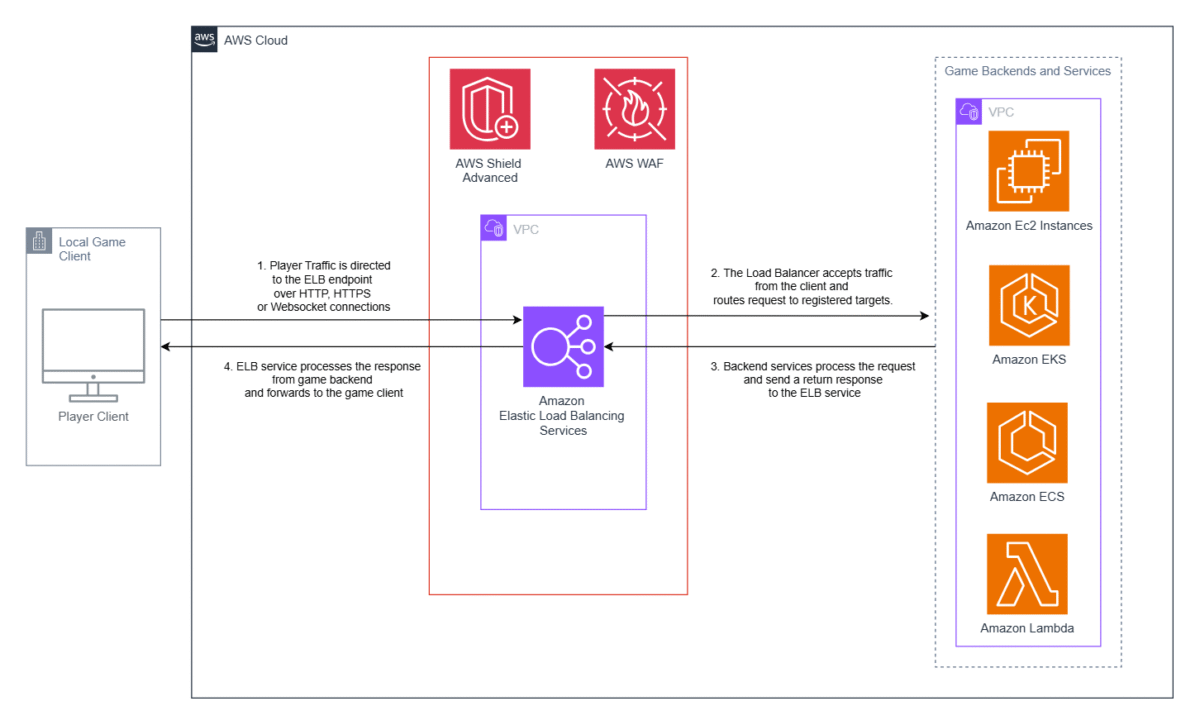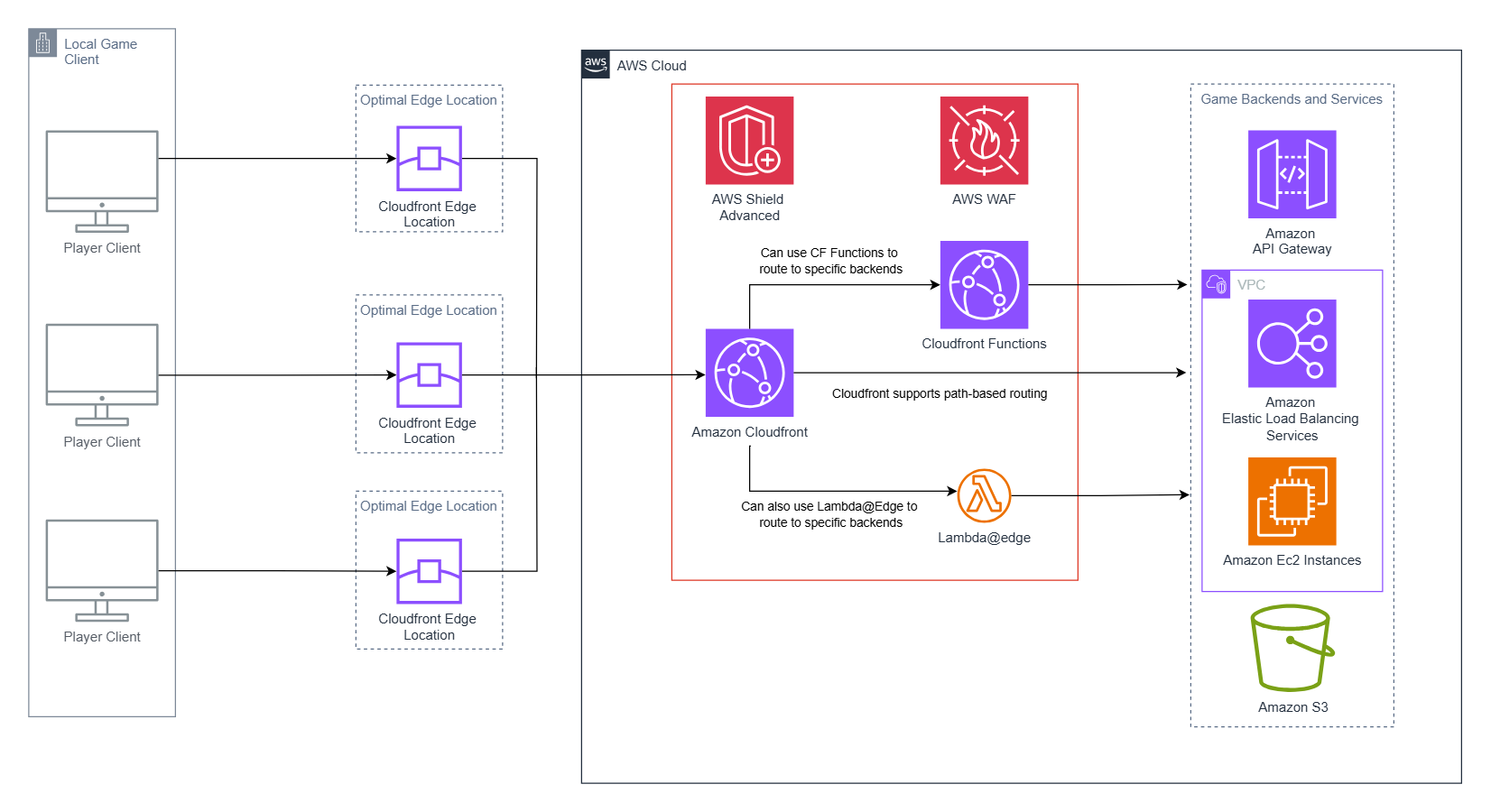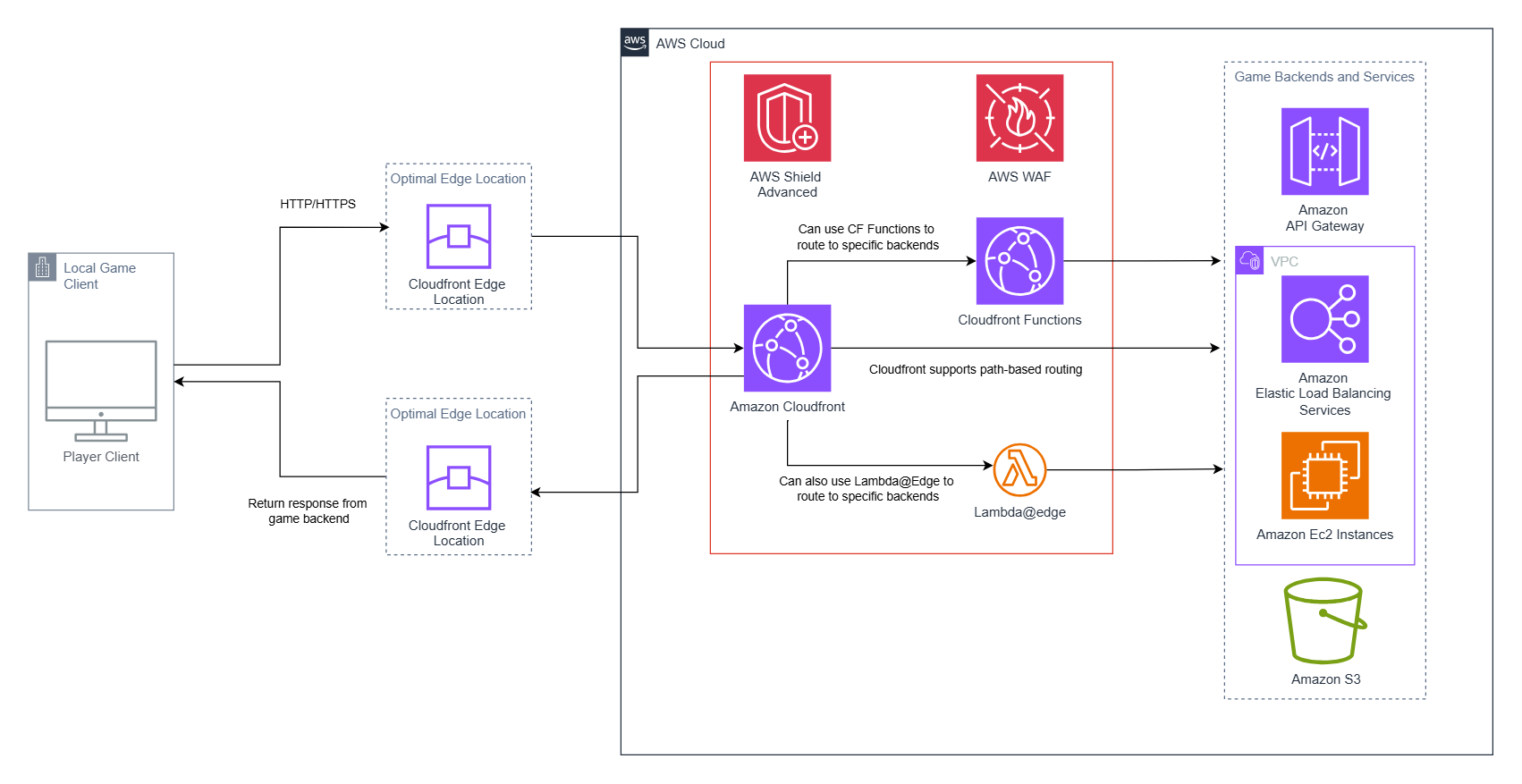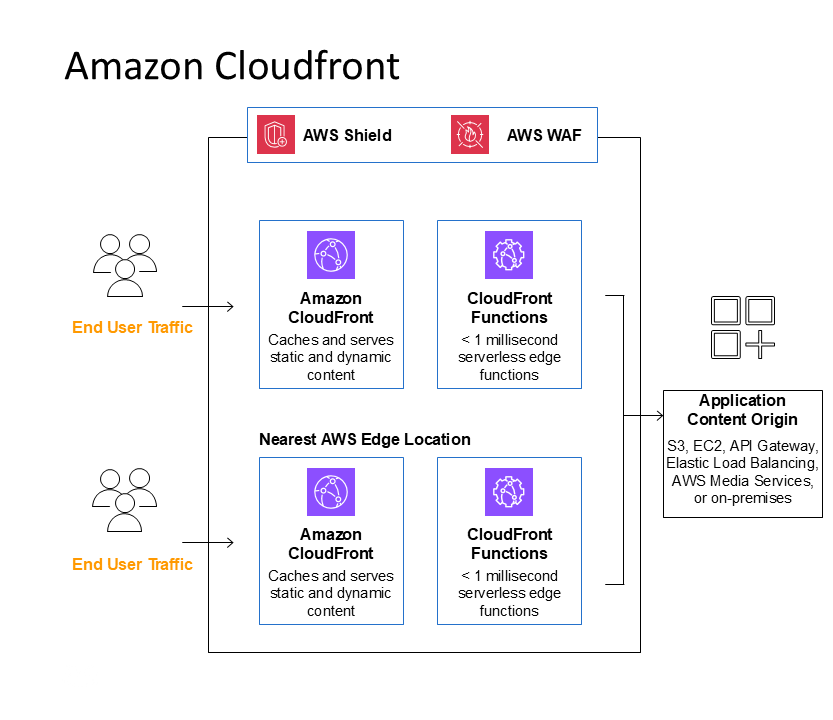
Building resilient and secure game backends with Amazon CloudFront

We’ll explore how Amazon CloudFront improves the performance, availability, and security of game backend services… Amazon CloudFront is a content delivery network (CDN) service commonly used to retrieve static content from the Amazon Web Services (AWS) network edge… These load balancers are …
In today’s gaming landscape, milliseconds can mean the difference between victory and defeat. Games have transformed from standalone experiences to always-on, live services. These services handle real-time multiplayer interactions, robust social features, and continual updates to meet the demands of players. Dynamic services need fast, reliable and secure backend infrastructure to deliver seamless experiences globally.
We’ll explore how Amazon CloudFront improves the performance, availability, and security of game backend services. Amazon CloudFront is a content delivery network (CDN) service commonly used to retrieve static content from the Amazon Web Services (AWS) network edge. The service can also act as a distributed, single point of entry for game services that use Application Load Balancers (ALBs) or Amazon API Gateway. Studios can then decouple their game from backend services and reduce operational overhead with caching and traffic management features.
Common architecture patterns for game backends
Traditionally, game backends on AWS use ALBs or Network Load Balancers (NLBs) to route player traffic to core services. These load balancers are often paired with Amazon Elastic Compute Cloud (Amazon EC2) instances Auto Scaling groups, AWS Lambda functions, or containerized services to dynamically run backend components, and have some form of distributed denial-of-service (DDoS) protection enabled. Additionally, some studios may use Amazon API Gateway to handle HTTP or HTTPS traffic and serverless API endpoints that route players to backends.
As more games include multiplayer modes or transition to always-on, live services, there are several key challenges that studios need to architect for:
- Centralized core services in a single region can increase latency or performance issues for players that are farthest from the central region.
- Security considerations for services that publicly expose load balancers or API Gateway endpoints. Live service games are prime targets for DDoS or man-in-the-middle (MITM) attacks, and studios need a way to obfuscate and protect these services.
Amazon CloudFront
What is Amazon CloudFront?
Amazon CloudFront is a CDN that enhances the performance, scalability, and security of web applications. It accelerates content delivery by routing user requests through the AWS Global Network to the most optimal edge location. CloudFront can securely deliver content from applications hosted in private subnets within an Amazon Virtual Private Cloud (Amazon VPC), using resources such as ALBs or Amazon EC2 instances as origins. It also integrates with Amazon API Gateway, helping to protect and accelerate REST APIs through caching, request filtering, and reduced latency with its global edge locations.
Key features for game studios
CloudFront provides several technical advantages for game studios managing games with multiplayer or live service components. It supports edge caching of static assets such as patch files, images, and game data, to reduce repeated origin requests and decrease latency for players.
For dynamic requests, like matchmaking and authentication APIs, CloudFront can lower latency by leveraging persistent connections and optimized routing through the AWS edge network. The service also integrates with AWS security services (such as AWS Shield and AWS WAF) for protection against DDoS attacks and fine-grained traffic filtering at the edge.
You can use CloudFront to deliver content from applications that are hosted in your Amazon VPC private subnets. You can additionally use ALBs and Amazon EC2 instances in private subnets as VPC origins. CloudFront also integrates with Amazon API Gateway to obfuscate and reduce latency to REST and HTTP APIs.
Finally, with CloudFront Functions, you can manipulate the requests and responses that flow through CloudFront, to perform functions for basic authentication and authorization, generate HTTP responses at the edge, and more.
Modernizing game backend platforms with Amazon CloudFront
Amazon CloudFront supports modern game backends, with performance, reliability, and security features that are essential for delivering exceptional gaming experiences. At its core, the global network of Points of Presence (POPs) of CloudFront dramatically reduces latency by positioning game infrastructure closer to players worldwide. It provides smooth gameplay across different geographical regions. The service’s automatic scaling capabilities handle traffic spikes during game launches or special events without requiring manual intervention, maintaining performance under pressure.
Routing layer for games backend
Games customers can use CloudFront as a routing layer to redirect traffic to game backend APIs. In this scenario, caching is not the primary concern, and every request is handled dynamically. CloudFront Functions can inspect headers and validate requests. Successful requests can be redirected to game APIs registered as origins. CloudFront can implement path-based routing to redirect HTTP requests to the right game backend service.
CloudFront also excels in traffic management through Lambda@Edge (a CloudFront feature) and CloudFront Functions. Developers can implement sophisticated features such as player authentication, matchmaking and user generated content management. Implementing custom logic does not add latency, while providing essential gaming features like regional routing and custom error handling. CloudFront Functions can manipulate the requests and responses that flow through CloudFront, perform basic authentication and authorization, generate HTTP responses at the edge and more.
Amazon CloudFront WebSocket support
Amazon CloudFront supports using WebSocket to enable near real-time communications essential for modern gaming experiences. During connection establishment, CloudFront manages the HTTP-to-WebSocket protocol upgrade, while maintaining persistent TCP connections between players and edge locations, as well as between edge locations and game backends. This dual-connection architecture leverages the global edge network of CloudFront to reduce latency and improve connection stability. Each edge location is capable of handling concurrent WebSocket connections that automatically scale based on player demand.
For game developers implementing features like real-time leaderboards, matchmaking lobbies, and chat systems, CloudFront automatically handles the complex networking requirements. This includes keep-alive messages, connection timeouts, and automatic failover capabilities.
As more games leverage CloudFront for multiplayer and always-on architectures, there are several key considerations for studios to architect for:
- Integrating CloudFront with Amazon CloudWatch (optional) enables comprehensive monitoring through detailed metrics and logging, helping teams maintain operational visibility and performance.
- Connections to API Gateway and Amazon Route 53 (optional) create a robust infrastructure backbone for globally distributed game backends.
This combination of connection management and observability makes WebSocket support especially valuable for multiplayer gaming architectures that demand both performance and reliability.
AWS WAF and AWS Shield integration with Amazon CloudFront
CloudFront combines AWS WAF and AWS Shield Advanced to deliver enterprise-grade protection for web applications. AWS WAF acts as a sophisticated web application firewall that monitors HTTP and HTTPS requests, controlling access based on customizable conditions like IP addresses, geographic origins, request headers, and query string values. The service provides comprehensive protection against common web vulnerabilities (including SQL injection and cross-site scripting (XSS) attacks) through its rule-based system that can allow, block, or count requests based on defined criteria.
The implementation of these security measures offers flexible response options through configurable rules. Security teams can establish rate-based rules that trigger when request thresholds are exceeded within specific time windows, providing defense against both targeted attacks and traffic anomalies. When creating a web Access Control List (ACL), administrators can specify CloudFront distributions for AWS WAF inspection. CloudFront supports both standard distributions for individual tenants and multi-tenant distributions that protect multiple clients through shared configuration templates.
AWS Shield complements AWS WAF by providing dedicated DDoS protection at the network (layer 3), transport (layer 4), and application (layer 7) levels of the OSI model. Shield Standard and Shield Advanced defend against attacks that attempt to overwhelm services with traffic from multiple compromised systems (botnet).
It should be noted that AWS Shield is part of AWS WAF, but has a separate API. AWS Shield has two plans: AWS Shield Standard and AWS Shield Advanced. AWS Shield Advanced is an extra cost. All AWS WAF customers automatically have AWS Shield Standard.
The multi-layered approach, combining the application-layer filtering of AWS WAF with the network and transport layer protection of AWS Shield, provides comprehensive security coverage. Together with the native features of CloudFront (such as custom SSL/TLS certificates and field-level encryption) these services create a robust security framework that protects both infrastructure and user data.
Operational excellence for global gaming architectures
CloudFront is an ideal solution for global gaming architectures, offering game development teams powerful capabilities to optimize their worldwide infrastructure. It enables the creation of multi-region cells for game backends, providing a robust foundation for international deployments. One of the key strengths of CloudFront is its ability to intelligently route traffic based on geography, seamlessly redirecting players to the closest region with a healthy cell. This facilitates low-latency experiences for gamers across the globe.
Furthermore, CloudFront enhances security and compliance by providing teams the ability to restrict access from regions where traffic is not expected or desired. This feature is particularly valuable for managing regional game releases or adhering to specific regulatory requirements.
Perhaps most critically, the global nature of CloudFront enables it to help with disaster recovery. In the event of a regional outage, teams can swiftly redirect all player traffic to another operational region, minimizing downtime and maintaining a seamless gaming experience.
By leveraging CloudFront, game developers can build resilient, performant, and secure global platforms that adapt to various scenarios, from optimal day-to-day operations to critical incident management. This comprehensive approach to content delivery and traffic management makes CloudFront an invaluable asset in modern game infrastructure, especially for titles with a worldwide player base.
For multi-region scenarios, game development teams can use tools like VPC Flow Logs and CloudWatch Internet Monitor, to gain complete visibility into global player traffic. This can help identify sources and destinations of traffic for optimal game management. CloudFront logs provide detailed records about requests that are made to a distribution. These logs are useful for games. For example, log information can be useful in security and access audits to protect players from account takeovers or fraud.
Using CloudWatch alarms, you can watch player traffic metrics over a time period that you specify. If a metric exceeds a given threshold, a notification is sent to an Amazon Simple Notification Service (Amazon SNS) topic or AWS Auto Scaling policy. This process can be used to scale up or down game backends using real-time signals.
Pricing considerations
AWS CloudFront pricing is designed to be both transparent and scalable. The CloudFront pricing model includes three primary components:
- Charges for data transfer out from edge locations to users
- Request fees based on the number, and type, of HTTP or HTTPS requests
- Optional fees for additional security features such as AWS Shield Advanced and AWS WAF
Pricing for CloudFront Functions and Lambda@Edge is based on the number of function invocations and compute time used. CloudFront Functions are generally more cost-effective for simple, frequent operations, while Lambda@Edge offers more flexibility for complex processing needs. It’s important to note that CloudFront Functions typically cost less than Lambda@Edge for simple, high-volume operations due to their lightweight nature.
When implementing CloudFront, consider the additional costs of supporting services for DNS management and observability. CloudWatch follows a pay-as-you-go model, charging for metrics, logs, and monitoring features beyond the free tier, with rates varying by region. Route 53 pricing includes fixed monthly fees for each hosted zone, usage-based DNS query charges, and costs for advanced features like health checks and specialized routing.
It’s important to note that when used with an AWS-based origin, the data transfer out of CloudFront replaces the origin’s data transfer out. As such, you do not pay the data transfer out of the origin.
Conclusion
We discussed how Amazon CloudFront can help game studios optimize their game backends with global edge computing and enhanced security integrations. CloudFront provides a unified entry point for game backend services that reduces latency, improves security, and streamlines traffic management.
Contact an AWS Representative to know how we can help accelerate your business.
Further reading
Author: Serge Poueme




